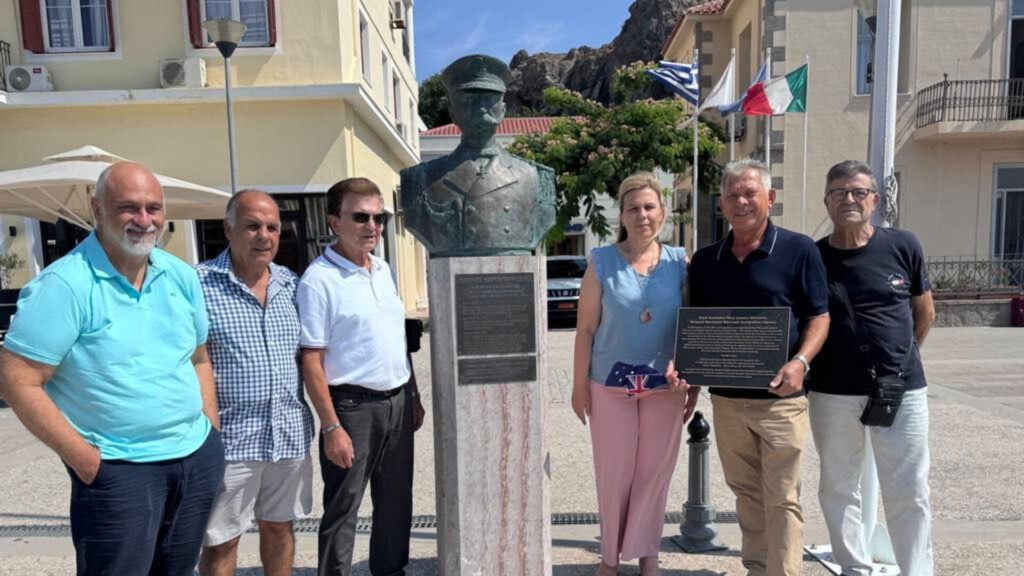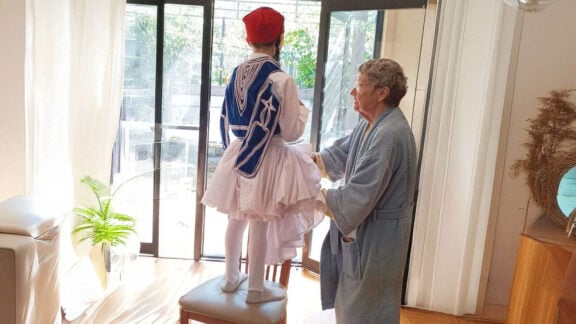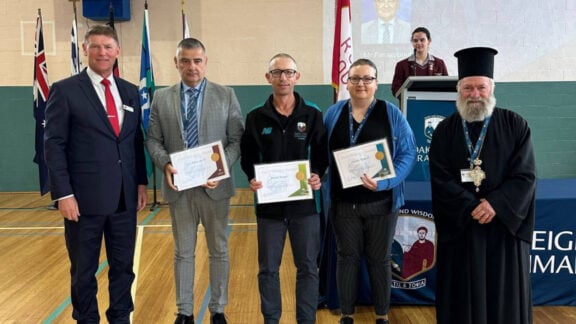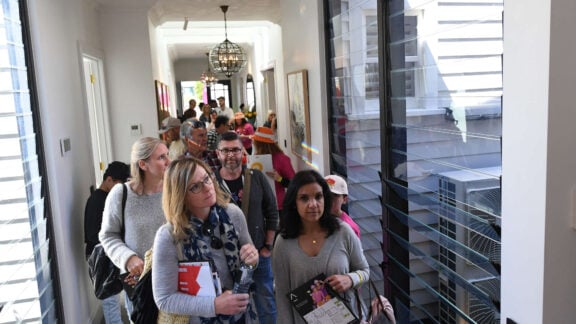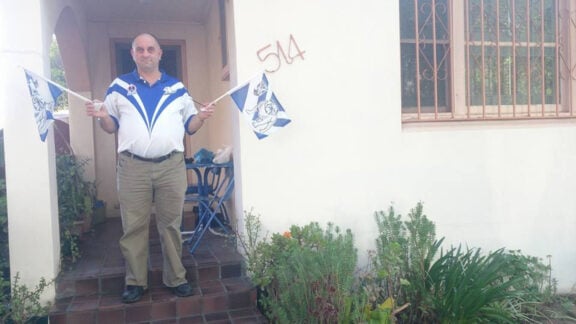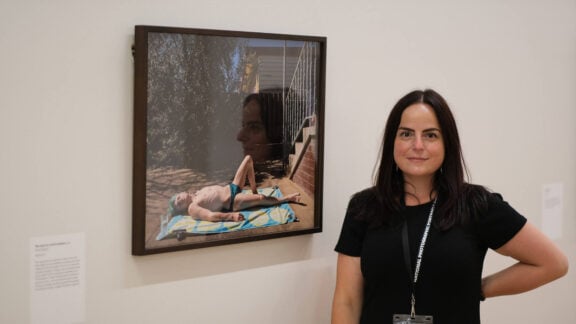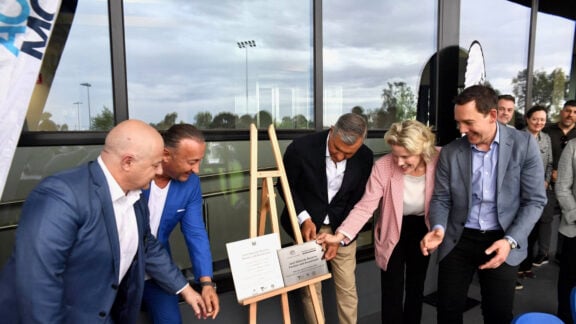A new memorial plaque honouring the service of the Royal Australian Navy (RAN) at Lemnos during the Gallipoli campaign of 1915-16 was recently presented to the authorities on Lemnos. The presentation is the culmination of a number of years work.
This new commemorative plaque was created and funded by Melbourne’s Lemnos Gallipoli Commemorative to commemorate the role of the Royal Australian Navy on Lemnos, including the AE2 submarine, the Royal Australian Naval Bridging Train engineers and the RAN Flotilla of 1918 and the RAN sailors buried on Lemnos. It was my pleasure to research, propose and organise the creation of this new memorial on behalf of our Committee.
The plaque was recently transported and presented to the Mayor of Lemnos Eleonora Georga by the Committee’s South Australian representative Peter Sotiropoulos, who was accompanied by the President of the Lemnian Federation of Australia Chris Maheras, Jim Elias and Jim Marinakis. The presentation ceremony took place in late July at the municipal offices at the port of Myrina, the capital of Lemnos. Sotiropoulos had travelled to Lemnos specifically to make this important presentation.
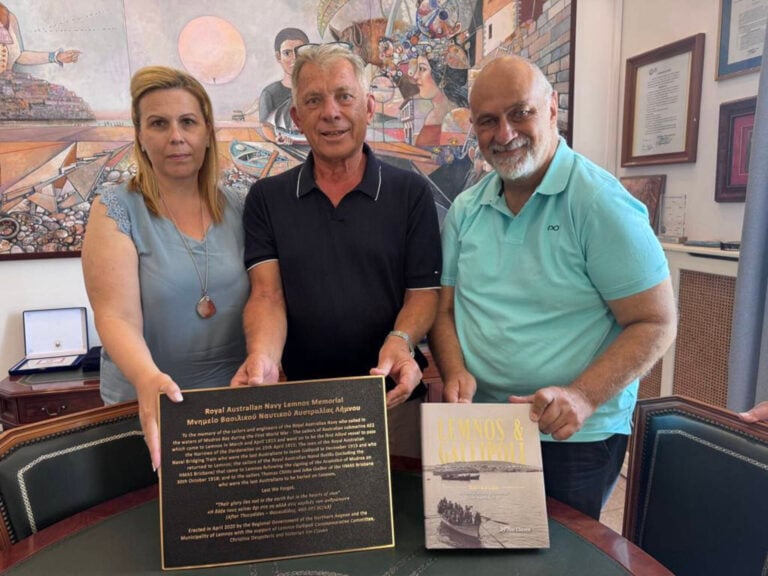
The role of Australia’s land-based personnel on Lemnos during the campaign is well-known – as the base for the troops as they made their way to and from the Gallipoli Peninsula and as the location of major medical facilities where Australian nurses and other medical staff served. Less appreciated is the connection between Lemnos and the RAN as it played its part in the Gallipoli campaign and beyond. The Committee created the Memorial to overcome this lack of awareness and to honour the service of RAN personnel on Lemnos during the campaign and after.
With its great harbour at Mudros and the nature of the campaign itself, the waters of Lemnos and surrounds played a key part in the unfolding campaign. This was the key to the role of the RAN in this important part in this aspect of Lemmos’ story.

The RAN’s connection to Lemnos begins with the story of one of Australia’s most famous naval vessels – the AE2 submarine – which came to Lemnos in the days in March 1915. Having sailed all the way from Australia, the AE2 would sail from Mudros Bay on the day of the landings at Anzac Cove – 25 April. This voyage would see the submarine and its crew successfully pass through the narrows of the Dardanelles and into the Sea of Marmara – the first Allied ship to do so. Fatefully, it was here that after an engagement with the enemy the submarine was scuttled by the crew on 30 April to stop her falling into enemy hands.
The next connection is that of the RAN’s logistics and engineering unit – the 1st Royal Australian Naval Bridging Train, one of the most decorated units in the RAN. Originally comprising nearly 400 men, this unit landed at Suvla Bay on 7 August 1915. These Australian naval engineers provided essential services to the troops fighting at the front, building and maintaining landing piers for the use of troops and supplies, repairing machinery and equipment in their workshops – all the while under enemy fire. They were also the last Australians to leave the Gallipoli peninsula during the December 1915 evacuation, going on to rest on Lemnos before departing for Egypt. One of these engineers would die of illness and be buried at the East Mudros Military Cemetery on Lemnos, Jersey-born 32-year-old Petty Officer Philip Le Seuer who had enlisted in Sydney.
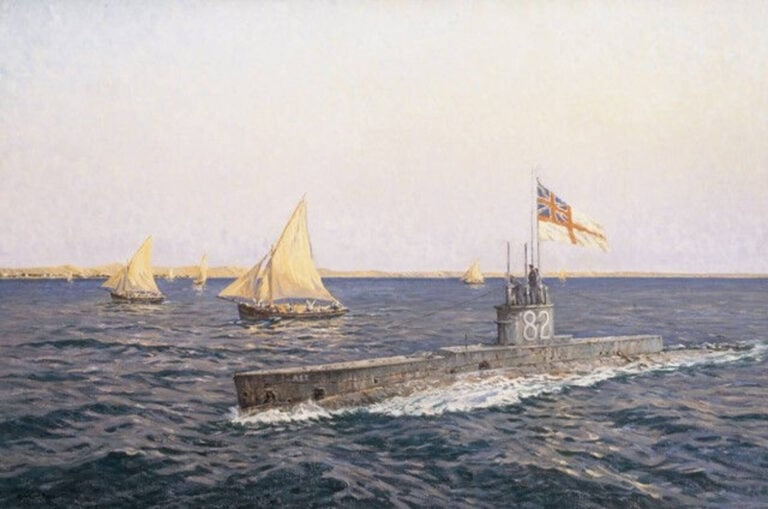
After the end of the Gallipoli campaign, six Royal Australian Navy warships – HMAS Brisbane, HMAS Parramatta, HMAS Swan, HMAS Warrego, HMAS Yarra and HMAS Huon – came to the waters of Mudros Bay and patrolled off the Gallipoli peninsula and Imbros in 1918 and would take part in the occupation of the Ottoman Empire. These ships had been engaged from September 1917 in patrolling the waters of the Adriatic and the Mediterranean. One of the most important missions assigned to these Australian ships occurred in January 1918, when HMAS Huon and HMAS Warrego were then entrusted to carry the Greek Premier Venizelos and his suite from Taranto to Athens on his return from an Allied conference in London.
Following the signing of the Armistice of Mudros in October 1918, three of these Australian vessels – HMAS Parramatta, HMAS Torrens and HMAS Brisbane – the latter Australia’s first Australian-built battleship – sailed from Lemnos and through the Dardanelles as part of the Allied fleet headed for the occupation of Constantinople following the signing of the Armistice, with three Australian warships following to take part in the occupation of Ottoman ports – HMAS Warrego, HMAS Swan and HMAS Huon.
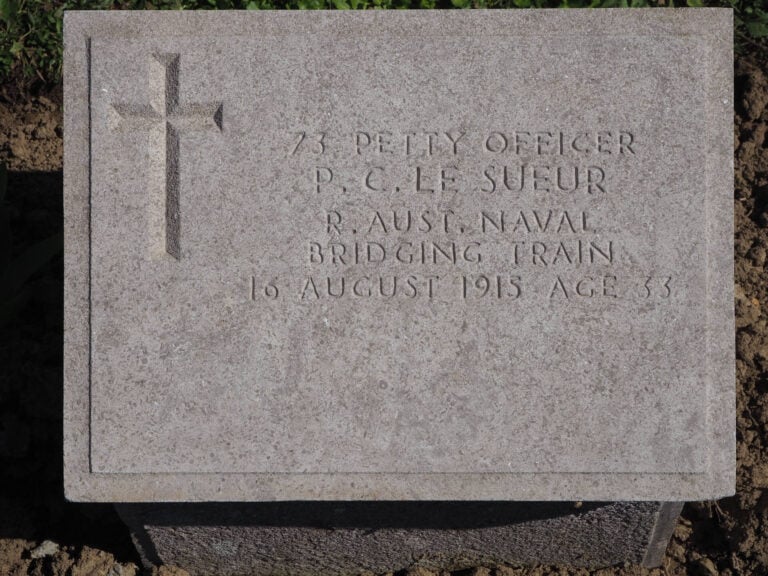
The end of the war also saw some of the last Australians to be buried on Lemnos. HMAS Brisbane, on its way to Smyrne harbour, buried two of its sailors at East Mudros Military Cemetery on 2 December 1918. Stoker John Godier from Bendigo and Able Seaman Thomas Chitts from Sandringham had both died of disease like many of their Anzac comrades in 1915. These would be last of the 148 Australian service personnel to be buried on Lemnos.
Finally, a physical reminder of the naval role of Lemnos’ part in the Gallipoli story and the possible part Australian service personnel played in this is the navigational beacon that stands at the end of the Turks Head Peninsula (also known as Pounda today). Neos Kosmos readers will be aware that I have written previously on the provenance of this structure.
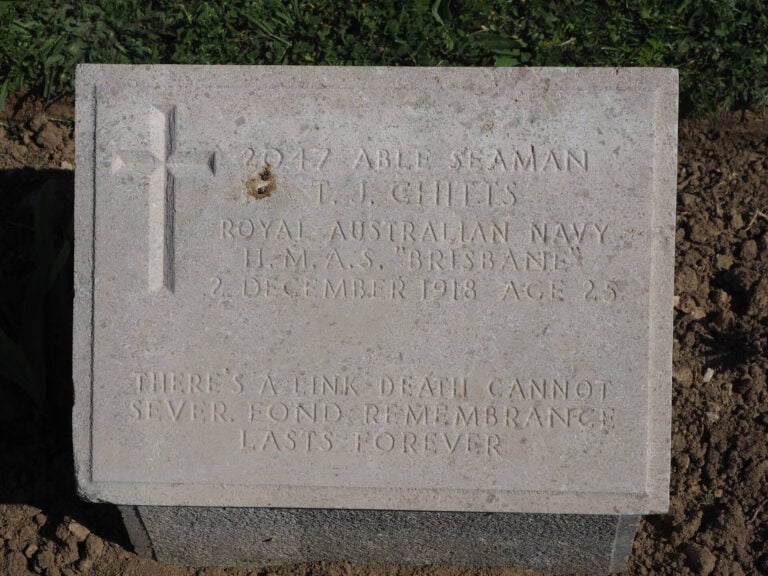
The erection of navigational beacons around Mudros Bay was an essential activity undertaken to protect the Allied fleet as it negotiated the dangers lurking beneath the waters of the bay. Their presence is recounted in the archives from the time. Indeed, after much research in British and Australian archives I have concluded that this particular structure (or a previous version of it) was present during the campaign and there is a distinct possibility that it was erected by Australian engineers. Where British naval maps from the time identify a “conspicuous” beacon at this location, the records 1st Australian Field Engineers Company – one of the first military engineering units to arrive on Lemnos (doing so in March 1915) – stating that they were engaged having “erected shore beacons” with one of its soldiers writing after the war that these were erected “around the harbor.”
The navigational beacon erected here not only has strong connections to the naval presence at Lemnos but it also stood witness to the Australian Navy’s connection to the Island – the passage of Australia’s AE2 submarine as it sailed to and from Lemnos in 1915, the arrival of the men of the Royal Australian Naval Bridging Train and that of HMAS Brisbane in late 1918.
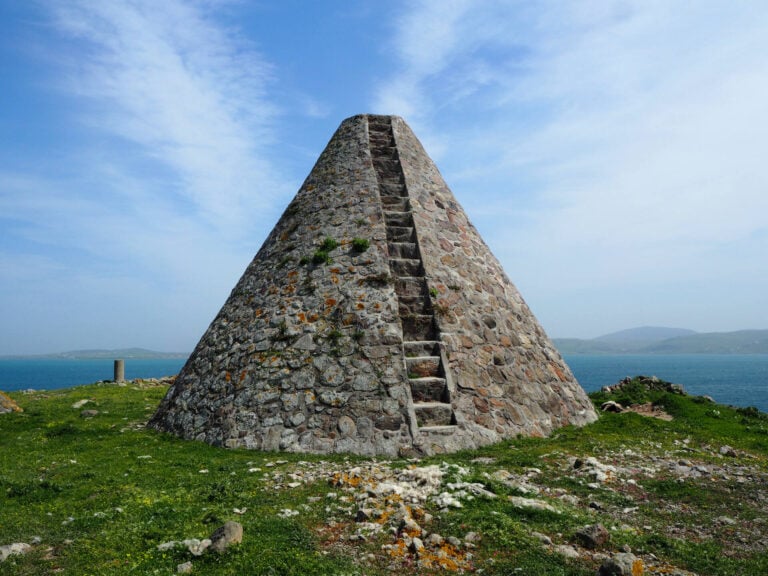
The significance of the RAN’s role at Lemnos was reinforced during the Anzac Centenary commemorations held on the Island in 2015. A major part of these was the participation of the RAN’s HMAS Success and its crew along with that of a ship of the Hellenic Navy. In coming to Lemnos’ Mudros Bay, HMAS Success was the first Australian warship to do so since the HMAS Brisbane in 1918.
It was fitting that Peter Sotiropoulos was able to visit these sites on Lemnos connected to the RAN’s connection to the Island – Mudros Bay, the beacon and the graves of the sailors at East Mudros. He said it was an honour to have played a part in the journey of this new and important commemorative memorial recognising the link between Australia and Lemnos. “Many Lemnians have made Australians their new home and this plaque recognises these young Australian naval personnel who came to Lemnos all those years ago”, he said.
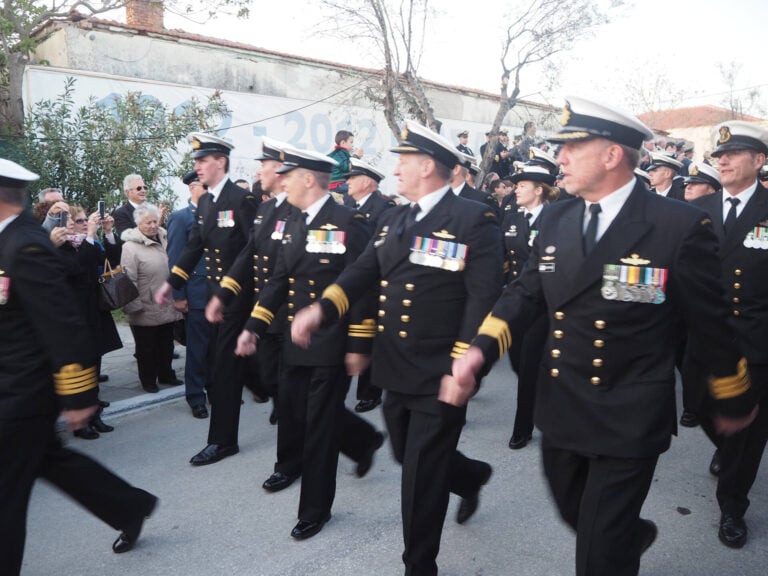
Lee Tarlamis OAM MP thanked Peter for helping to bring the Memorial to Lemnos and thanked the Municipality for accepting this important commemorative gift. “Our Committee has worked over many years – both in Australia and Greece – to raise awareness and to commemorate the Hellenic link to Australia’s Anzac tradition. I place on record our Committee’s recognition of the work of our Secretary – historian Jim Claven OAM – in proposing and bringing this project to fruition. This new Memorial represents our continuing commitment to contributing to the creation of Lemnos’ Anzac trail, joining the Australian Pier Memorial which we helped created a few years ago”, he said.
In accepting the plaque along with the Mayor Eleonora Georga, Deputy Mayor Dimitris Boulotis expressed the appreciation by the Municipality of the work of the Committee and its on-going endeavours to have Lemnos role in Gallipoli recognized. “The Committee has been working with the Municipality on Lemnos for many years. This new Memorial is further evidence of the creative partnership between the Committee and the people of Lemnos. We look forward to the installation of this important new Memorial in coming months”, he said.
The Committee is now in discussions with the Lemnos municipality to determine the most fitting location for the new Memorial on Lemnos.

Jim Claven OAM is a trained historian, freelance writer and published author who has been researching the Hellenic link to Australia’s Anzac story for many years. He is the author of Lemnos & Gallipoli Revealed, a comprehensive study of the role of the Island in the Gallipoli campaign, as well as Secretary of the Lemnos Gallipoli Commemorative Committee. His research led to the creation of the Australian Pier Memorial on Lemnos as well as the new RAN Memorial. He can be contact via email – jimclaven@yahoo.com.au
